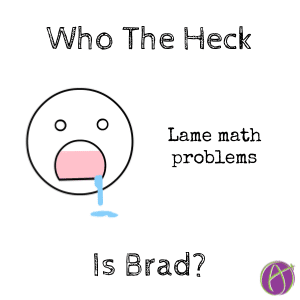Shift to Show Your Thinking
In 2017 math instruction shifts from “do these math problems” to “explain your thinking.” This is a good thing. Photomath will show students the procedural steps to a math problem, technology has replaced “show your work.” Instead, we look for students having number fluency, being able to do a problem different ways and to explain their thinking.
Slapping on Explain
Adding the word “Explain” is one way to value the understanding over the answer, but slapping on the word explain does not increase engagement. This math problem was shared with me
“How many hours does Brad spend grooming in a week? Explain your reasoning.”
I was getting my hair done when this was messaged to me. My hairdresser, when I showed her, said “who is Brad?” Exactly. Who is Brad and why do I care about him? This contrived chart does not connect students to their learning and it lacks student engagement. My first thought it “who cares.” Bet some students agree with me.
This question is from a major textbook publisher. PEOPLE PAY MONEY FOR THIS JUNK. Why in 2017 are we tolerating such lame contrived questions for our students? Textbook publishers need to do better than this.
Grooming
Do people actually say they spend time grooming? Is this a term students connect to or relate to?
Fractional Time
I have never once measured time I spent doing something in fractions. This is such an inauthentic use case.
DOK
This problem is not critical thinking. It is DOK 1. How can the textbook publishers help teachers increase the critical thinking for students besides just slapping the word explain on the same old tired math problems?
Any C’s?
Collaboration? Nope.
Critical Thinking? Nope.
Creative Thinking? Possibly depending on how the kid explains their reasoning… probably will explain their steps so nope.
Clearly Communicating Ideas? Yes. If the student’s explanation goes beyond procedural steps.
Still lame? Yup.
Design for Student Engagement
Be a teacher that designs the learning environment, not one that assigns chapter 5 section 6 odds. Look at those math problems, how can we make them more authentic? How can we engage students in mathematics?
Instant Relevance
Want some great examples of how to avoid using contrived examples? Check out Denis Sheeran (denissheeran.com) and his book Instant Relevance.
Students probably would find watermelon catapults worth mathematically investigating. Brad… who is Brad?












1 thought on “Who The Heck is Brad?”
Saw my name and made me laugh!